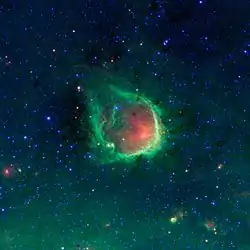RCW 120
RCW 120 is an emission nebula and H II region in the southern Milky Way and located some 4,300 light-years from Earth.[1]
| Emission nebula | |
|---|---|
| H II region | |
 | |
| Observation data: J2000 epoch | |
| Right ascension | 17h 12m 23.2s |
| Declination | −38° 26′ 51.2″ |
| Distance | 4,300 ly |
| Constellation | Scorpius |
| Designations | GUM 58 Sh 2-3 Green Ring Nebula |
Its designation appears in the RCW Catalogue published in 1960, whose circular diameter size is 6 arcmin.[2] It also catalogued as Sh 2-3 and Gum 58.
Veta S. Avedisova considers RCW 120 is being ionised by the O8 V star CD -38 11636 and the B2 V star VDBH 84B, and places the nebula in the star formation region SFR 348.26+0.47 along with 3 masers and the radio HII region CH87 347.386+0.266.
The Herschel infra-red telescope's image shows an embryonic star that is likely to become one of the brightest stars in our Galaxy at some time within the next few hundred thousand years. The star now appears about ten times more massive than the Sun and may grow much larger by accreting material from the surrounding gas and dust.[3]
External links
References
- "BBC News : Herschel space telescope pierces giant star bubble". Retrieved 26 February 2017.
- Rodgers, A. W.; Campbell, C. T.; Whiteoak, J. B. (1960), "A catalogue of Hα-emission regions in the southern Milky Way", Monthly Notices of the Royal Astronomical Society, 121 (1): 103–110, Bibcode:1960MNRAS.121..103R, doi:10.1093/mnras/121.1.103, retrieved 2007-01-30
- "Science Codex: RCW 120 and the hidden side of star birth". Retrieved 26 February 2017.